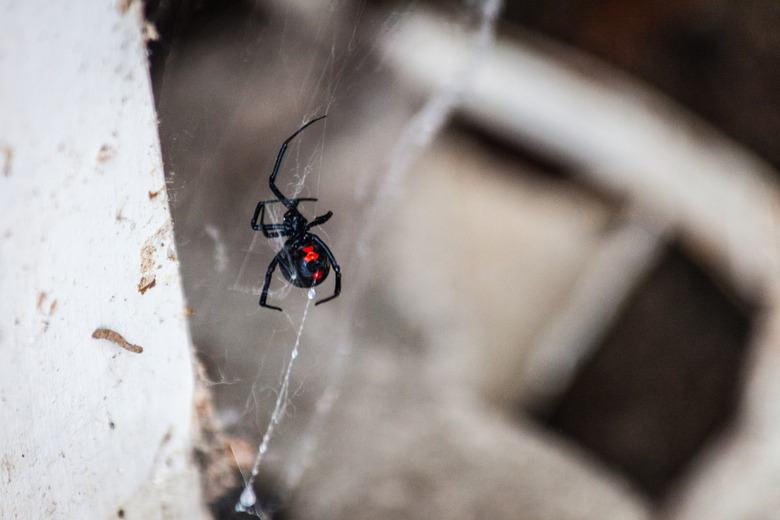How To Tell The Difference Between Poisonous And Non-Poisonous Spiders
Pop quiz: Was the spider you found creeping up your bedroom wall dangerous? If you answered, "I don't know," you're not alone. Knowing the difference between a potentially dangerous spider and one that is harmless is important — especially if you live in an area that is known for harmful spiders. But how do you quickly ID those eight-legged predatory arachnids without completely freaking out? If you're concerned about spiders in your home or yard, it might be a good idea to buy an identification book that has pictures of some of the more common spiders. That way, when you run across one you have a quick reference guide at your fingertips.
Which Spiders Are the Most Dangerous?
Which Spiders Are the Most Dangerous?
There are over 400,000 types of spiders living on every continent except Antartica, but despite what you might think, very few of them have lethal bites. Spiders are made to bite smaller creatures, not humans. Therefore, the amount of venom they release during a bite is rarely lethal to humans. Problems arise when the skin lesions produce an allergic reaction, that can be fatal.
Spiders to Avoid
Spiders to Avoid
There are plenty of spiders to avoid — some more than others. Here are some of the more common spiders that are considered the most dangerous in the United States.
Red widow spider: An easy one to identify because of its prominent red color. It is most often found in central and southern Florida.
Black widow spider: This spider is easy to identify because it is shinny black and has a red-yellow design on the abdomen. In the United States, they are most often found in the South and West. The venom a black widow releases is a neurotoxin and produces pain at the bite area, which can spread to the chest, abdomen and entire body. It will be fairly easy to identify a black widow bite. The bite makes two puncture marks in the skin.
Brown widow spider: This spider is more powerful than the black widow and can be found in southern California, as well as the Gulf coast. It is brown and black and has a distinctive geometric pattern.
Brown recluse spider: Considered one of the most dangerous spiders in the United States, the brown recluse is most commonly found in the Midwestern and southern states. It is light brown to dark brown and a little bigger than a penny. Because the venom can cause a severe lesion by destroying skin tissue, it is recommended that you seek medical attention if you get bit by a brown recluse.
Hobo spider: While not considered one of the most dangerous, the hobo can cause some serious side effects if you're bitten by one. They like to hide in the basement and other undisturbed areas. Their appearance varies so they can be difficult to identify.
Common Spiders That Are Not Dangerous
Common Spiders That Are Not Dangerous
Once you become familiar with the more dangerous spiders that are native to your region, you can identify the other eight-legged critters that are hanging out in your house and around your yard.
Common house spider: These spiders like to hang out in basements, window frames and under furniture. Most of these spiders are considered harmless.
Jumping spider: These spiders can be identified by their unique eye pattern (they have four eyes). They may look fury and frightening, but they are not dangerous.
Wolf spider: The wolf spider almost needs a category of its own. They are found all around the world, but the United States is home to 125 species. The wolf spider is nocturnal and their bite can be painful but not fatal. If you come across a wolf spider, more than likely, they will retreat. They only become aggressive if provoked.
Other harmless spiders include the cobweb spider, sac spider, cellar spiders and crab spiders.
Cite This Article
MLA
Lindberg, Sara. "How To Tell The Difference Between Poisonous And Non-Poisonous Spiders" sciencing.com, https://www.sciencing.com/how-to-tell-the-difference-between-poisonous-and-non-poisonous-spiders-13405725/. 23 August 2018.
APA
Lindberg, Sara. (2018, August 23). How To Tell The Difference Between Poisonous And Non-Poisonous Spiders. sciencing.com. Retrieved from https://www.sciencing.com/how-to-tell-the-difference-between-poisonous-and-non-poisonous-spiders-13405725/
Chicago
Lindberg, Sara. How To Tell The Difference Between Poisonous And Non-Poisonous Spiders last modified March 24, 2022. https://www.sciencing.com/how-to-tell-the-difference-between-poisonous-and-non-poisonous-spiders-13405725/
